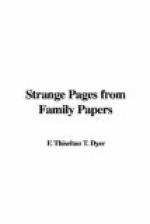There are numerous rooms of this curious description which, it must be remembered, were, in many cases, the outcome of religious intolerance in the sixteenth century, and early in the seventeenth, when the celebration of Mass in this country was forbidden. Hence those families that persisted in adhering to the Roman Catholic faith oftentimes kept a priest, who celebrated it in a room—opening whence was a secret one, to which in case of emergency he could retreat. Evelyn in his Diary, speaking of Ham House, at Weybridge, belonging to the Duke of Norfolk, as having some of these secret rooms, writes: “My lord, leading me about the house, made no scruple of showing me all the hiding places for Popish priests, and where they said Masse, for he was no bigoted papist.” The old Manor House at Dinsdale-upon-Tees has a secret room, which is very cleverly situated at the top of the staircase, to which access is gained from above. The compartment is not very large, and is between two bedrooms, and alongside of the fireplace of one of them. “It would be a very snug place when the fire was lighted,” writes a correspondent of “Notes and Queries,” “and very secure, as it is necessary to enter the cockloft by a trap door at the extreme end of the building, and then crawl along under the roof into the hiding-place by a second trap-door.” Among further instances of these curious relics of the past may be mentioned Armscott Manor, two or three miles distant from Shipston-on-Stour. According to a local tradition, George Fox at one time lived here. In a passage at the top of the house is the entrance to a secret room, which receives light from a small window in one of the gables, and in this room George Fox is said to have been concealed during the period he was persecuted by the county magistrates.




